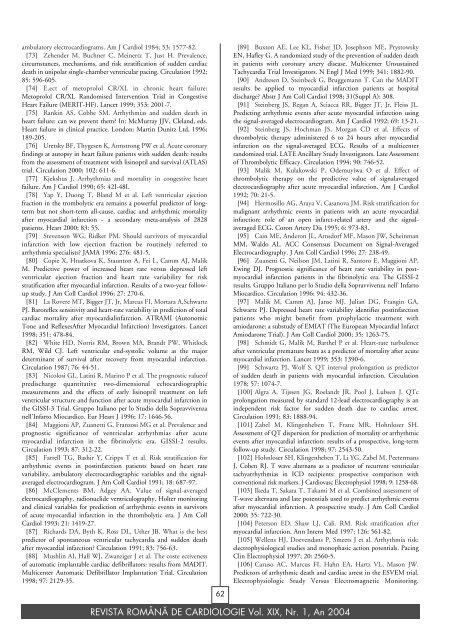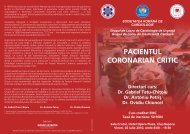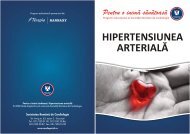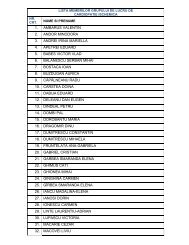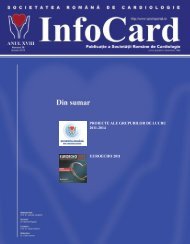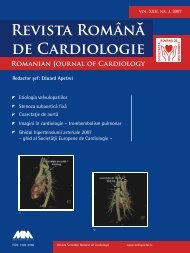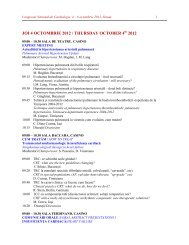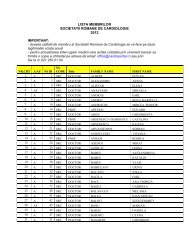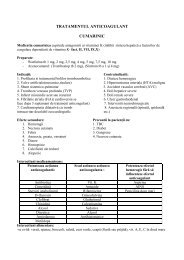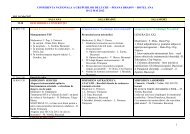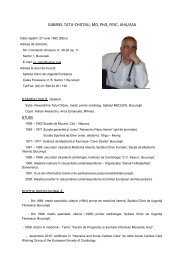Click aici pentru detalii
Click aici pentru detalii
Click aici pentru detalii
You also want an ePaper? Increase the reach of your titles
YUMPU automatically turns print PDFs into web optimized ePapers that Google loves.
ambulatory electrocardiograms. Am J Cardiol 1984; 53: 1577-82.<br />
[73] Zehender M, Buchner C, Meinertz T, Just H. Prevalence,<br />
circumstances, mechanisms, and risk stratification of sudden cardiac<br />
death in unipolar single-chamber ventricular pacing. Circulation 1992;<br />
85: 596-605.<br />
[74] E.ect of metoprolol CR/XL in chronic heart failure:<br />
Metoprolol CR/XL Randomised Intervention Trial in Congestive<br />
Heart Failure (MERIT-HF). Lancet 1999; 353: 2001-7.<br />
[75] Rankin AS, Cobbe SM. Arrhythmias and sudden death in<br />
heart failure: can we prevent them? In: McMurray JJV, Cleland, eds.<br />
Heart failure in clinical practice. London: Martin Dunitz Ltd, 1996;<br />
189-205.<br />
[76] Uretsky BF, Thygesen K, Armstrong PW et al. Acute coronary<br />
findings at autopsy in heart failure patients with sudden death: results<br />
from the assessment of treatment with lisinopril and survival (ATLAS)<br />
trial. Circulation 2000; 102: 611-6.<br />
[77] Kjekshus J. Arrhythmias and mortality in congestive heart<br />
failure. Am J Cardiol 1990; 65: 42I-48I.<br />
[78] Yap Y, Duong T, Bland M et al. Left ventricular ejection<br />
fraction in the trombolytic era remains a powerful predictor of longterm<br />
but not short-term all-cause, cardiac and arrhythmic mortality<br />
after myocardial infarction - a secondary meta-analysis of 2828<br />
patients. Heart 2000; 83: 55.<br />
[79] Stevenson WG, Ridker PM. Should survivors of myocardial<br />
infarction with low ejection fraction be routinely referred to<br />
arrhythmia specialists? JAMA 1996; 276: 481-5.<br />
[80] Copie X, Hnatkova K, Staunton A, Fei L, Camm AJ, Malik<br />
M. Predictive power of increased heart rate versus depressed left<br />
ventricular ejection fraction and heart rate variability for risk<br />
stratification after myocardial infarction. Results of a two-year followup<br />
study. J Am Coll Cardiol 1996; 27: 270-6.<br />
[81] La Rovere MT, Bigger JT, Jr, Marcus FI, Mortara A,Schwartz<br />
PJ. Baroreflex sensitivity and heart-rate variability in prediction of total<br />
cardiac mortality after myocardialinfarction. ATRAMI (Autonomic<br />
Tone and ReflexesAfter Myocardial Infarction) Investigators. Lancet<br />
1998; 351: 478-84.<br />
[82] White HD, Norris RM, Brown MA, Brandt PW, Whitlock<br />
RM, Wild CJ. Left ventricular end-systolic volume as the major<br />
determinant of survival after recovery from myocardial infarction.<br />
Circulation 1987; 76: 44-51.<br />
[83] Nicolosi GL, Latini R, Marino P et al. The prognostic valueof<br />
predischarge quantitative two-dimensional echocardiographic<br />
measurements and the effects of early lisinopril treatment on left<br />
ventricular structure and function after acute myocardial infarction in<br />
the GISSI-3 Trial. Gruppo Italiano per lo Studio della Sopravvivenza<br />
nell’Infarto Miocardico. Eur Heart J 1996; 17: 1646-56.<br />
[84] Maggioni AP, Zuanetti G, Franzosi MG et al. Prevalence and<br />
prognostic significance of ventricular arrhythmias after acute<br />
myocardial infarction in the fibrinolytic era. GISSI-2 results.<br />
Circulation 1993; 87: 312-22.<br />
[85] Farrell TG, Bashir Y, Cripps T et al. Risk stratification for<br />
arrhythmic events in postinfarction patients based on heart rate<br />
variability, ambulatory electrocardiographic variables and the signalaveraged<br />
electrocardiogram. J Am Coll Cardiol 1991; 18: 687-97.<br />
[86] McClements BM, Adgey AA. Value of signal-averaged<br />
electrocardiography, radionuclide ventriculography, Holter monitoring<br />
and clinical variables for prediction of arrhythmic events in survivors<br />
of acute myocardial infarction in the thrombolytic era. J Am Coll<br />
Cardiol 1993; 21: 1419-27.<br />
[87] Richards DA, Byth K, Ross DL, Uther JB. What is the best<br />
predictor of spontaneous ventricular tachycardia and sudden death<br />
after myocardial infarction? Circulation 1991; 83: 756-63.<br />
[88] Mushlin AI, Hall WJ, Zwanziger J et al. The coste ectiveness<br />
of automatic implantable cardiac defibrillators: results from MADIT.<br />
Multicenter Automatic Defibrillator Implantation Trial. Circulation<br />
1998; 97: 2129-35.<br />
62<br />
[89] Buxton AE, Lee KL, Fisher JD, Josephson ME, Prystowsky<br />
EN, Hafley G. A randomized study of the prevention of sudden death<br />
in patients with coronary artery disease. Multicenter Unsustained<br />
Tachycardia Trial Investigators. N Engl J Med 1999; 341: 1882-90.<br />
[90] Andresen D, Steinbeck G, Bruggemann T. Can the MADIT<br />
results be applied to myocardial infarction patients at hospital<br />
discharge? Abstr J Am Coll Cardiol 1998; 31(Suppl A): 308.<br />
[91] Steinberg JS, Regan A, Sciacca RR, Bigger JT, Jr, Fleiss JL.<br />
Predicting arrhythmic events after acute myocardial infarction using<br />
the signal-averaged electrocardiogram. Am J Cardiol 1992; 69: 13-21.<br />
[92] Steinberg JS, Hochman JS, Morgan CD et al. Effects of<br />
thrombolytic therapy administered 6 to 24 hours after myocardial<br />
infarction on the signal-averaged ECG. Results of a multicenter<br />
randomized trial. LATE Ancillary Study Investigators. Late Assessment<br />
of Thrombolytic Efficacy. Circulation 1994; 90: 746-52.<br />
[93] Malik M, Kulakowski P, Odemuyiwa O et al. Effect of<br />
thrombolytic therapy on the predictive value of signalaveraged<br />
electrocardiography after acute myocardial infarction. Am J Cardiol<br />
1992; 70: 21-5.<br />
[94] Hermosillo AG, Araya V, Casanova JM. Risk stratification for<br />
malignant arrhythmic events in patients with an acute myocardial<br />
infarction: role of an open infarct-related artery and the signalaveraged<br />
ECG. Coron Artery Dis 1995; 6: 973-83.<br />
[95] Cain ME, Anderon JL, Arnsdorf MF, Mason JW, Scheinman<br />
MM, Waldo AL. ACC Consensus Document on Signal-Averaged<br />
Electrocardiography. J Am Coll Cardiol 1996; 27: 238-49.<br />
[96] Zuanetti G, Neilson JM, Latini R, Santoro E, Maggioni AP,<br />
Ewing DJ. Prognostic significance of heart rate variability in postmyocardial<br />
infarction patients in the fibrinolytic era. The GISSI-2<br />
results. Gruppo Italiano per lo Studio della Sopravvivenza nell’ Infarto<br />
Miocardico. Circulation 1996; 94: 432-36.<br />
[97] Malik M, Camm AJ, Janse MJ, Julian DG, Frangin GA,<br />
Schwartz PJ. Depressed heart rate variability identifies postinfarction<br />
patients who might benefit from prophylactic treatment with<br />
amiodarone: a substudy of EMIAT (The European Myocardial Infarct<br />
Amiodarone Trial). J Am Coll Cardiol 2000; 35: 1263-75.<br />
[98] Schmidt G, Malik M, Barthel P et al. Heart-rate turbulence<br />
after ventricular premature beats as a predictor of mortality after acute<br />
myocardial infarction. Lancet 1999; 353: 1390-6.<br />
[99] Schwartz PJ, Wolf S. QT interval prolongation as predictor<br />
of sudden death in patients with myocardial infarction. Circulation<br />
1978; 57: 1074-7.<br />
[100] Algra A, Tijssen JG, Roelandt JR, Pool J, Lubsen J. QTc<br />
prolongation measured by standard 12-lead electrocardiography is an<br />
independent risk factor for sudden death due to cardiac arrest.<br />
Circulation 1991; 83: 1888-94.<br />
[101] Zabel M, Klingenheben T, Franz MR, Hohnloser SH.<br />
Assessment of QT dispersion for prediction of mortality or arrhythmic<br />
events after myocardial infarction: results of a prospective, long-term<br />
follow-up study. Circulation 1998; 97: 2543-50.<br />
[102] Hohnloser SH, Klingenheben T, Li YG, Zabel M, Peetermans<br />
J, Cohen RJ. T wave alternans as a predictor of recurrent ventricular<br />
tachyarrhythmias in ICD recipients: prospective comparison with<br />
conventional risk markers. J Cardiovasc Electrophysiol 1998; 9: 1258-68.<br />
[103] Ikeda T, Sakata T, Takami M et al. Combined assessment of<br />
T-wave alternans and late potentials used to predict arrhythmic events<br />
after myocardial infarction. A prospective study. J Am Coll Cardiol<br />
2000; 35: 722-30.<br />
[104] Peterson ED, Shaw LJ, Cali. RM. Risk stratification after<br />
myocardial infarction. Ann Intern Med 1997; 126: 561-82.<br />
[105] Wellens HJ, Doevendans P, Smeets J et al. Arrhythmia risk:<br />
electrophysiological studies and monophasic action potentials. Pacing<br />
Clin Electrophysiol 1997; 20: 2560-5.<br />
[106] Caruso AC, Marcus FI, Hahn EA, Hartz VL, Mason JW.<br />
Predictors of arrhythmic death and cardiac arrest in the ESVEM trial.<br />
Electrophysiologic Study Versus Electromagnetic Monitoring.<br />
REVISTA ROMÅN~ DE CARDIOLOGIE Vol. XIX, Nr. 1, An 2004


